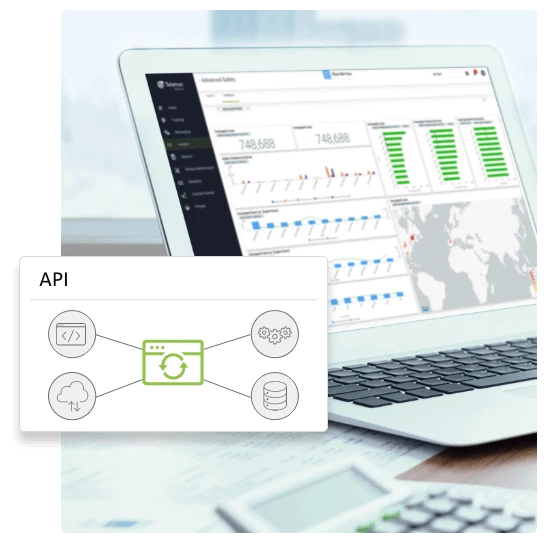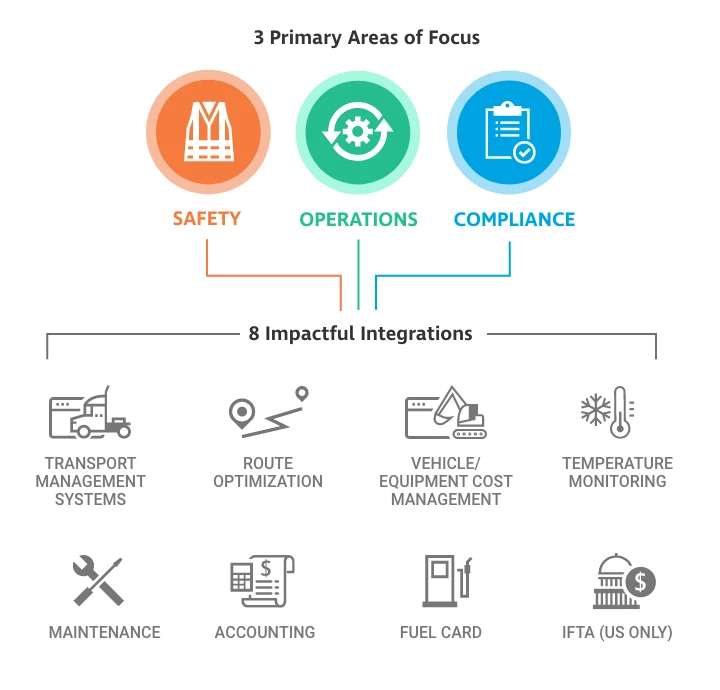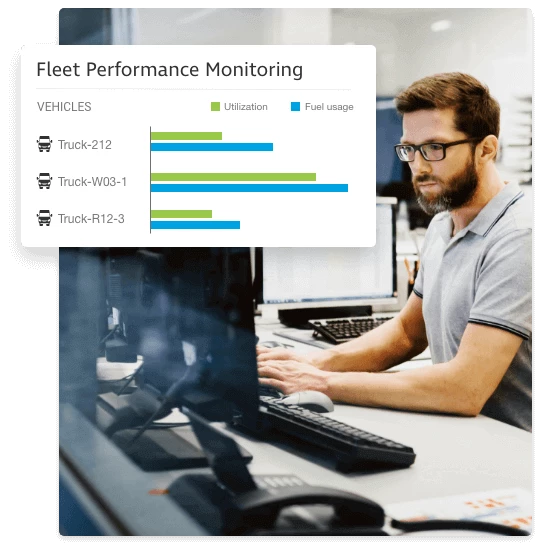Key Takeaways
Fleet management software is essential for any business that relies on vehicles and equipment for daily operations, and as technology continues to advance and businesses look for ways to gain competitive advantage, its capability to seamlessly integrate is becoming increasingly important.
This guide provides a comprehensive overview of how fleet management software integrations work, the type of integrations that are commonly created and the steps businesses should go through to create successful integrations. With this information, you can take advantage of all of the benefits that come with the ability to turn data into decisions and keep your business moving forward.
Table of Contents
1. How Do Fleet Management Software Integrations Work?
2. Types of Fleet Management Software Service Integration
3. Fleet Management Software Integration: Steps for Success
How Do Fleet Management Software Integrations Work?
Fleet management software integrations can take many different forms and customer needs vary based on the size of the business and the industry they operate in. However, the key reason to integrate fleet management software is to bring all information into one place to create a more comprehensive overview of business operations.
Integration Process
The process of integrating fleet management software involves connecting different software applications to improve workflow efficiency, operational visibility and data accuracy. The software programs used by fleet operations are all capturing and using information and the purpose of the integration is to bring this information together into a single system. In this sense, the software serves as a conduit for either retrieving or posting information.
Many enterprise fleet management software applications have pre-configured integrations with industry partners offering a simple way to bring the data together. When a pre-configured integration isn’t available an Application Programming Interface (known as an API) can be used to build the integration. An API is a set of definitions and protocols that let the software applications communicate and share information.

Types of Fleet Management Software Integration
When planning out a fleet management software integration there are three primary areas of focus, these are operations, safety and compliance. Here are 8 of the most impactful integrations for fleet operations.
- Route Optimization. Integrations with route planning and optimization software enable the most efficient routes to be pushed into a fleet management platform where job management tools, including proof of delivery and GPS routing, can be used. Route compliance data and proof of delivery details are pushed back to the route optimization software enabling plan vs. actual analysis.
- Accounting integrations. These can include payroll, expense tracking and invoicing to stay on top of fleet costs. Some of the most frequent accountancy integrations share business mileage data to automate mileage expense claims, start and end times (derived by ignition on) to validate timesheets and time on site information to calculate invoice costs.
- Vehicle / Equipment Cost Management. Fleet management software helps businesses run their fleet effectively every day and gathers valuable data that should be used to assess total cost of ownership and when making decisions on replacement cycles. Integrating data such as utilization and maintenance cost will provide insights that support more effective fleet resourcing decisions.
- Fuel Card. Integrations with fuel card providers enable fleet managers to check that vehicles are at the filling station when fuel card charges were recorded and that the amount of fuel being dispensed isn’t above the capacity of the vehicles tank. This helps to ensure that all the fuel being purchased is being used in company vehicles.
- Maintenance. Many fleet management systems include maintenance scheduling applications, but there is sometimes a need for a dedicated maintenance platform, this is especially true when maintenance is managed in house. By pulling in vehicle odometer, engine hours and pre/post-trip inspection data, maintenance applications can automate maintenance scheduling and work order creation.
- Temperature Monitoring. By pulling in temperature data from the refrigeration unit on your truck or trailer, the back office can monitor and receive alerts on temperature changes that can affect load condition. This helps businesses take proactive steps to protect temperature sensitive cargo.
- Transport Management Systems. For many transport operations their transport management system (TMS) is central to their operation covering planning, billing and dispatching. By integrating fleet management software real-time driver hours of service data can be used for load planning, proof or delivery can be used for billing and trip data can be used to monitored route adherence.
- IFTA (US Only). By integrated location and mileage data with a fuel tax reporting and pre-auditing software package you can automate the process of managing cross state fuel tax and ensure that you are paying the right amount of tax to each state and are staying compliant with federal tax requirements.

Fleet Management Software Integration: Steps For Success
While many businesses are apprehensive about the fleet software integration process, it’s important to remember it’s just an exchange of data. The process begins by identifying a provider with a proven reputation and excellent customer support that can support you from scoping through launch and into the maintenance phase. You will also want a provider with experience working with businesses of a similar size and within a similar industry as yours to ensure alignment with your business needs.
Here are some key milestones to keep in mind during the implementation.
Step 1: Identify Business Needs and Goals
Before starting the integration process you must first identify the business needs and goals that the solution should address. The best approach is to enter the process without any preconceived notions, regardless of whether you have used similar systems in the past. Work with your provider by discussing your desired outcomes first. This will allow you to work backwards from there and into customized solutions.
Step 2: Determine Integration Capabilities
Once your needs and goals have been identified, work with your provider to determine the specifics of the integrations you will require. To facilitate a connected environment, your provider will need to understand how the software best fits with your existing business operations, what pieces of your business need to be optimized and the types of data you will be exchanging back and forth between systems.
Step 3: Plan and Prepare an Integration Strategy
Once all integrations have been accounted for, you will need to plan your integration strategy. This involves deciding on the timing of integrations, the logistics of data transfers and data preparation. This may involve a multi-stage process, and your data may need to be cleaned and standardized to ensure proper mapping and compatibility.
Step 4: Test and Troubleshoot Your Integration
Once the data set is ready, you will need to test your integrations to ensure data transfers are occurring as expected. This may involve running various test scenarios and validation tests to identify any errors or issues. If any concerns are identified, you can troubleshoot with your provider to remediate the anomalies.
Step 5: Go Live and Monitor Performance
Once all integrations have been tested, it’s time to roll out your integrated fleet management software with your provider. You will want to continue monitoring performance in the live environment to ensure all data transfers are accurate and optimal. Review the data regularly and adjust integrations as necessary to ensure continued success.

Teletrac Navman’s TN360 platform has been designed to optimize performance for any fleet operation. With years of expertise processing telematics data and a commitment to delivering premier customer service solutions, the TN360 platform offers the ideal enterprise fleet management software solution for all fleet needs.
One of the key highlights of the TN360 platform is its compatibility with the wide range of data sources made possible by an Open API that allows businesses to integrate with other software platforms more easily.
Whether you’re managing a large-scale mixed fleet operation, a small-scale business fleet or anything in between, the TN360 platform can be scaled to meet your needs and adapted over time. Build and price your own custom solution in just 30 seconds and discover how TN360 can meet the needs of your business, you can also contact our team, and one of our product experts will work with you to answer your fleet management software questions.

